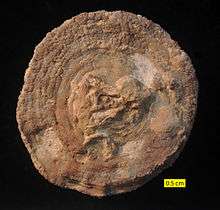Beekite

Beekite is a distinctive form of chalcedony usually associated with silica replacing carbonate minerals in fossils (e.g. the top part of the coral illustrated).[1]
Beekite, recognised as small, concentric rings (cylinders, ellipsoids, or spheres in 3D) of microcrystalline quartz is recorded as first brought to attention of geologists by Henry Beeke, probably from studies around Torbay.[2] Early studies were reported by Thomas McKenny Hughes, in Devon,[3] and R. Etheridge in Australia.[4]
A study of the taphonomy of silicified fossils (especially brachiopods) in Devon concluded beekite resulted from the aerobic decomposition of organic matter in an environment with a limited supply of silica during early diagenesis.[5] Elsewhere, beekite has been compared to silcrete, indicating a break in sedimentation, where it occurs as encrustations on clasts of carbonate rock in the Palaeocene alluvial fan deposits of central Anatolia.[6]
References
- ↑ Beekite on Mindat.org
- ↑ Henry William Bristow (1861). Glossary of Mineralogy. London: Longman, Green, Longman, and Roberts. pp. 38–39. Retrieved 14 November 2014. (Archived at the Biodiversity Heritage Library)
- ↑ T. M. McKenny Hughes (1889). "On the manner of occurrence of Beekite and its bearing upon the origin of Siliceous Beds of Palaeozoic Age" (PDF). The Mineralogical Magazine and Journal of the Mineralogical Society. London: Simpkin, Marshall, Hamilton, Kent & Co., Ltd. 8: 265–271. doi:10.1180/minmag.1889.008.40.02. Retrieved 14 November 2014.
- ↑ R. Etheridge, Jnr. (1893). "On the occurrence of Beekite in connection with "fossil organic remains" in New South Wales" (PDF). Records of the Australian Museum. 2 (5): 74–76, plate xvi. doi:10.3853/j.0067-1975.2.1893.1197. Retrieved 14 November 2014.
- ↑ H.K. Holdaway & C.J. Clayton (1982). "Preservation of shell microstructure in silicified brachiopods from the Upper Cretaceous Wilmington Sands of Devon". Geological Magazine. 119: 371–382. doi:10.1017/s0016756800026285.
- ↑ Kazanci, Nizamettin and Baki Varol, The occurrence and significance of beekite in Palaeocene alluvial-fan deposits in central Anatolia, Turkey, Terra Nova, Volume 5, Issue 1, pages 36–39, January 1993